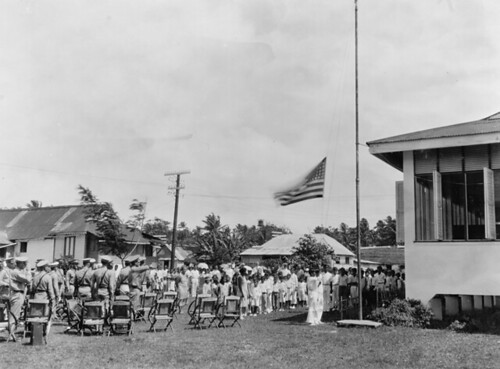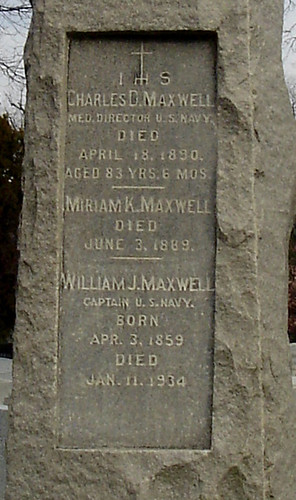Governor William John Maxwell
US Naval Captain William John Maxwell (1859 – 1934) was Governor of Guam from 28 March 1914 – 29 April 1916. Maxwell relieved Acting Governor Alfred Walton Hinds and continued previous Naval Government infrastructure projects. In addition, he reorganized government agencies, established financial institutions, petitioned the US Navy Department for Guam’s US citizenship and to open the port for commercial use.
Maxwell later exhibited signs of mental instability and after nervous breakdown he was ordered by doctors to be relieved of duty. In 1930, Governor Willis Bradley renamed the school in Sumai in Maxwell’s honor.
Before Guam
William J. Maxwell was born 3 April 1859 to parents Mariam and Charles Maxwell. He had an older sister, Anna Harris Eastman. He attended the US Naval Academy in 9 June 1874 and graduated on 22 June 1882. Maxwell trained on the USS Jamestown and continued to served on the Galena, Dolphin and Vesuvius before attaining lieutenant on 6 April 1897. He continued on assignments to the Columbia, Sylph, Marietta and became a member of the Special Service Board. From 1911 until his appointment as Governor of Guam he commanded the Florida.
Governor of Guam
According to Maxwell’s 1914 Governor of Guam Annual Report, after relieving Hinds as Governor, he examined the island and found it barely operational. He initiated programs for solidifying the Naval Government’s internal structure. Maxwell had each Government position’s duties and authority defined. The Insular Patrol was reorganized to fall under the local Police Force and village Commissioners. In extension the Aide to the Governor was responsible for the Commissioners.
Bank of Guam
Maxwell issued Executive Order No. 193 on 14 December 1915 to establish the islands first bank, Bank of Guam. It opened 3 January 1916 and was under the control of the Naval Government. Bank of Guam networked with banks located in Manila, Hong Kong, Shanghai, Yokohama, Sydney, Honolulu and San Francisco. The Board of Managers included: the Naval Governor of Guam as Chairman; Comptroller; Auditor of Guam; the Treasurer of the Naval Government of Guam; and holder of Certificate of Deposit records (an elected position).
Service Pension Foundation
The Guam Government Service Pension Foundation was established by Maxwell’s Executive Order No. 182 in May 1914. It created a Governing Committee of five members including the Governor. This Committee had the authority to invest funds on behalf of its members and members were able to request loans. Members consisted of Government employees and their next of kin.
US Navy Department (USND)
Maxwell appealed to the USND to grant the people of Guam US citizenship in 1914. He believed it was a logical step forward in strengthening the island through business and administration. His appeal was rejected while a young President Franklin Delano Roosevelt was Acting Secretary of the Navy.
Commercial port
Maxwell appealed to open Guam a commercial port. He observed the increased dependence on Naval Government imports. Maxwell believed a commercial port would improve Guam’s disposition and boost local economy. Maxwell appealed to the USND and was again rejected. Pres. Roosevelt was Assistant Secretary of the Navy during this appeal.
SMS Cormoran II
14 December 1914 German auxiliary cruiser, the SMS Cormoran II, anchored in Apra Harbor in need of coal and supplies. Maxwell could not accommodate and the following day Cormoran Captain, Adalbert Zuckschwerdt, accepted Maxwell’s terms of internment. According to Charles Burdick, author of “The Frustrated Raider,” this marked the beginning of a personal war between Captain Zuckschwerdt VS. Governor Maxwell.
Maxwell and Zuckschwerdt’s personal war began with the Cormoran’s finances. From Washington, DC, German Ambassador Johann Graf von Bernstorff was forwarding funds to the Cormoran through the USND. Maxwell distributed a portion of the amount without explanation and Zuckschwerdt did not agree or understand his decisions. The following months they continued to disagree over coded messages, how the crew spent their money, curfews, protocols, international law and basic human rights. These disputes often involved and were settled by the USND and Ambassador Bernstorff. Zuckschwerdt tried to have the Cormoran transferred to San Francisco but was unsuccessful.
Change of command
On 29 April 1916, Maxwell was declared unfit to continue his duties as Governor of Guam and was relieved by Comdr. William P. Cronan of the USS Supply. He was escorted by a Marine guard aboard the USAT Thomas 30 May 1915. Maxwell arrived in Washington, DC, in the company of a physician and sent to the Naval hospital. He was then assigned to the Naval war college in Newport. Shortly afterward he retired in 9 August 1917. US Naval Captain William John Maxwell passed away on 11 January 1934.
For further reading
Anderson, John C. “William John Maxwell (1859-1934).” Find A Grave, 6 March 2010.
Burdick, Charles. The Frustrated Raider. Carbondale: Southern Illinois University Press, 1979.
Executive General Orders Nos. 180-194, 2 April 1914 – 13 January 1916. Naval Government of Guam. Government House.
Farrell, Don A. The Pictorial History of Guam: The Americanization 1898-1918. 2nd ed. Tamuning: Micronesian Productions, 1986.
Hamersly, Lewis Randolph. The Records of Living Officers of the US Navy and Marine Corps. 5th ed. Philadelphia: L.R. Hamersly & Co., 1894.
“Probing Odd Navy Case.” The Washington Post, 26 August 1916.
Rogers, Robert. Destiny’s Landfall: A History of Guam. Honolulu: University of Hawai`i Press, 1995.
Sanchez, Pedro C. Guahan Guam: The History of Our Island. Hagåtña: Sanchez Publishing House, 1987.
US Naval Government of Guam. Governor of Guam Annual Report. By Roy C. Smith. Hagåtña: GH, 1916.
–––. Governor of Guam Annual Report. By William J. Maxwell. Hagåtña: GH, 1915.
US, Select Military Registers, 1862-1985 [database on-line]. Ancestry.com Operations, Inc., 2013.
Ward, Herbert T. The Flight of the Cormoran. New York: Vantage Press, 1970.






